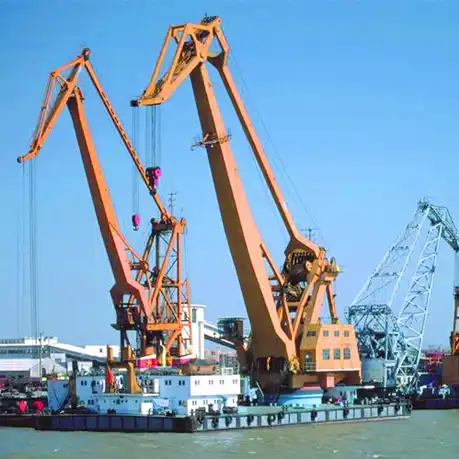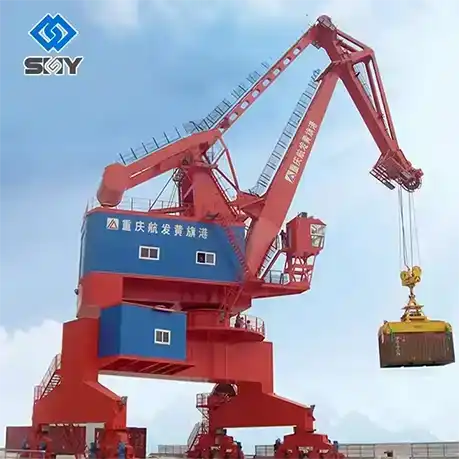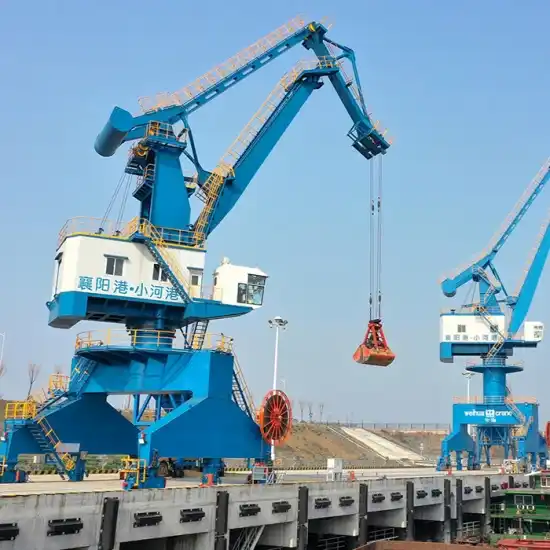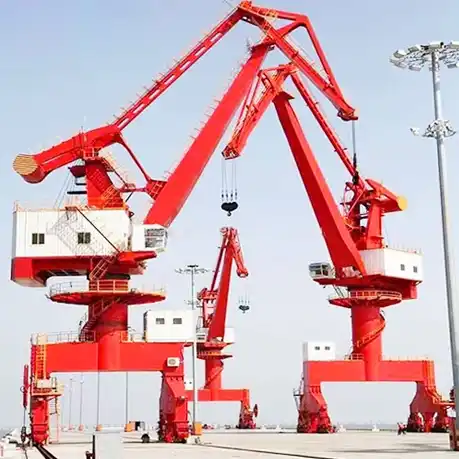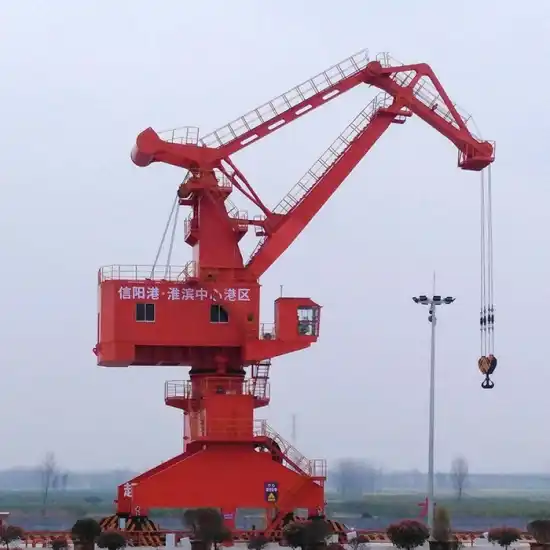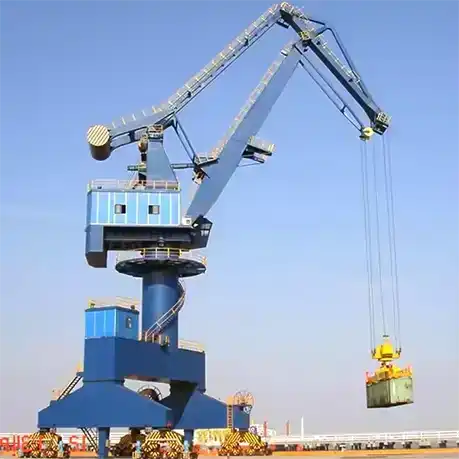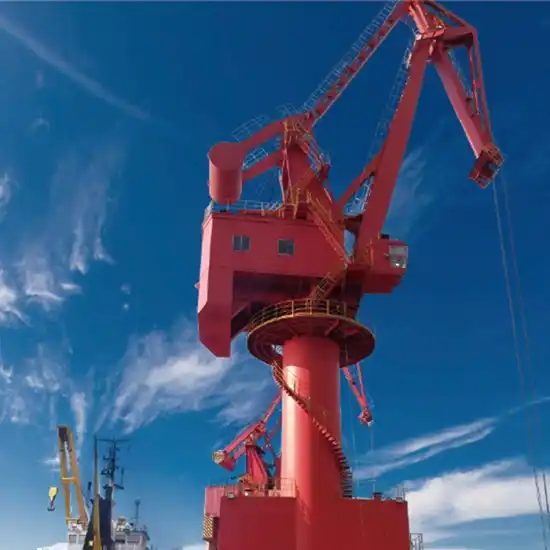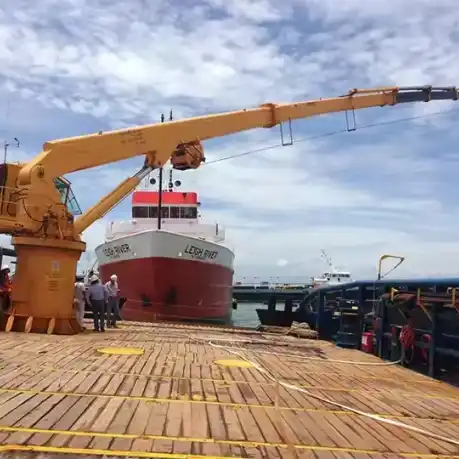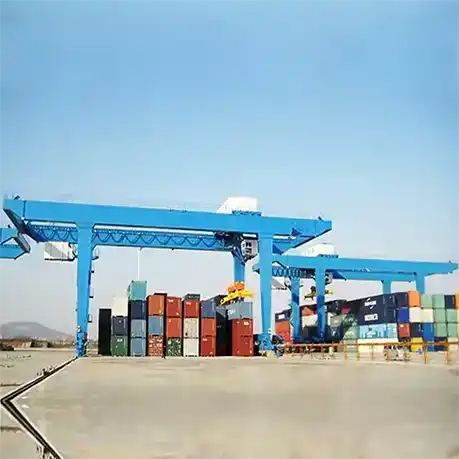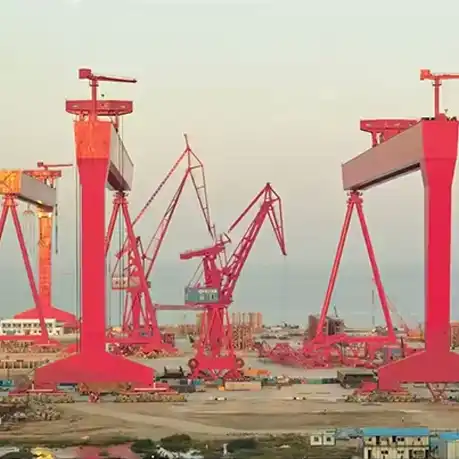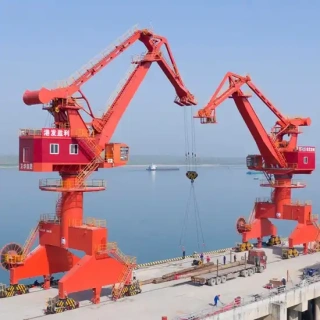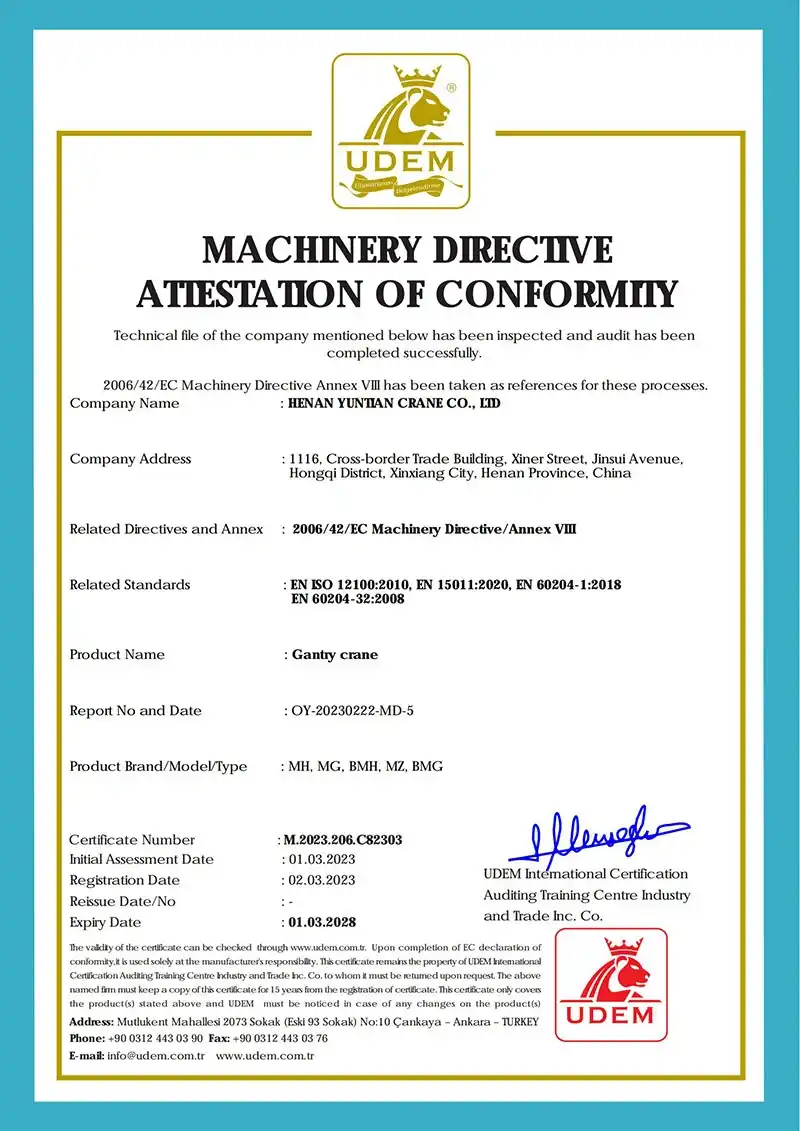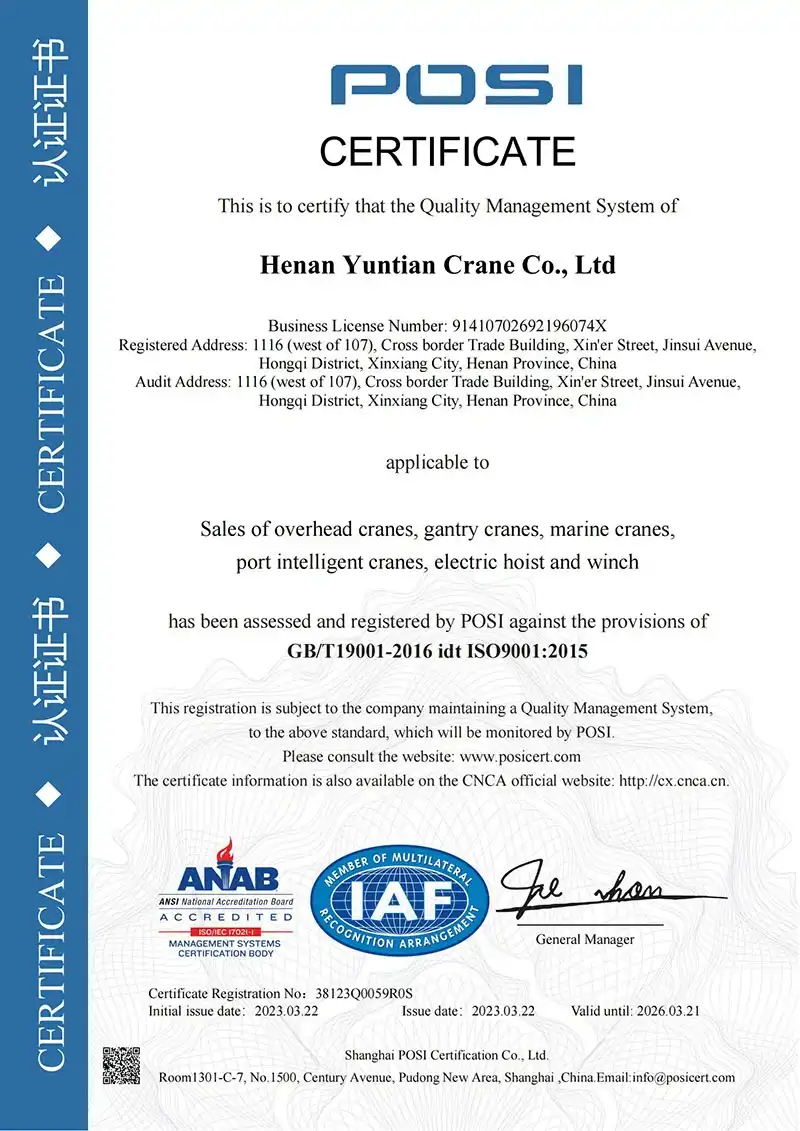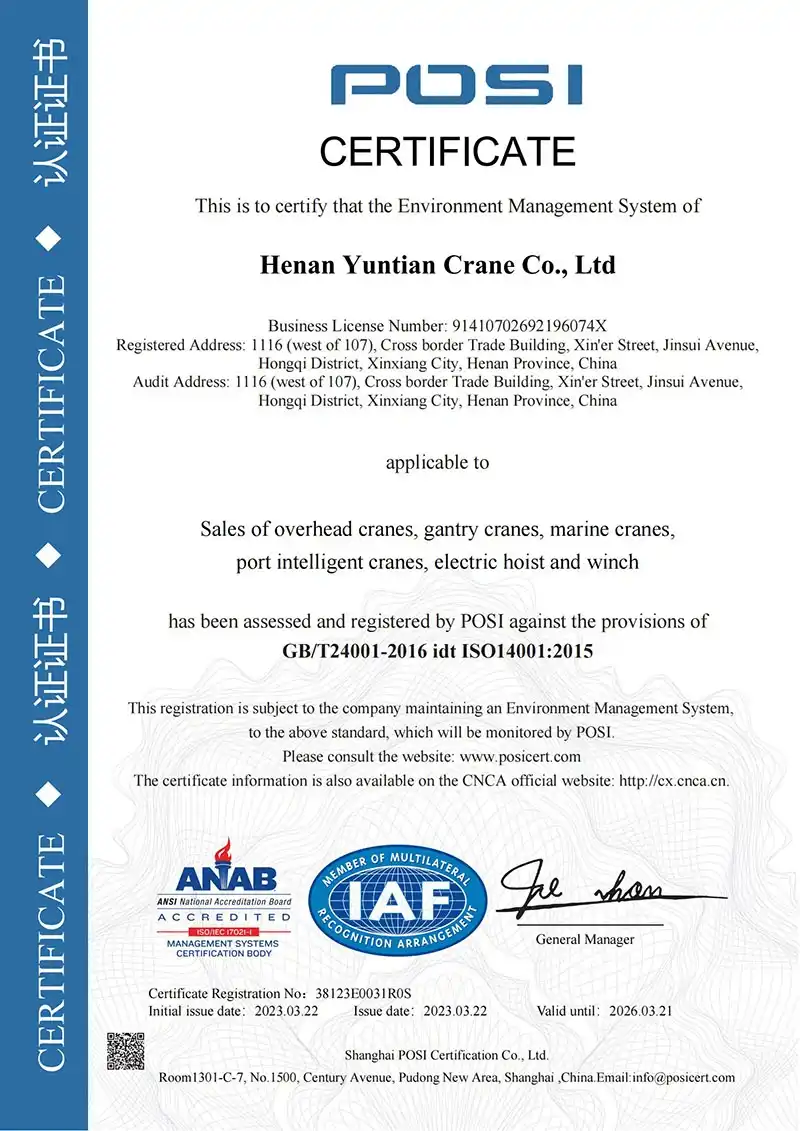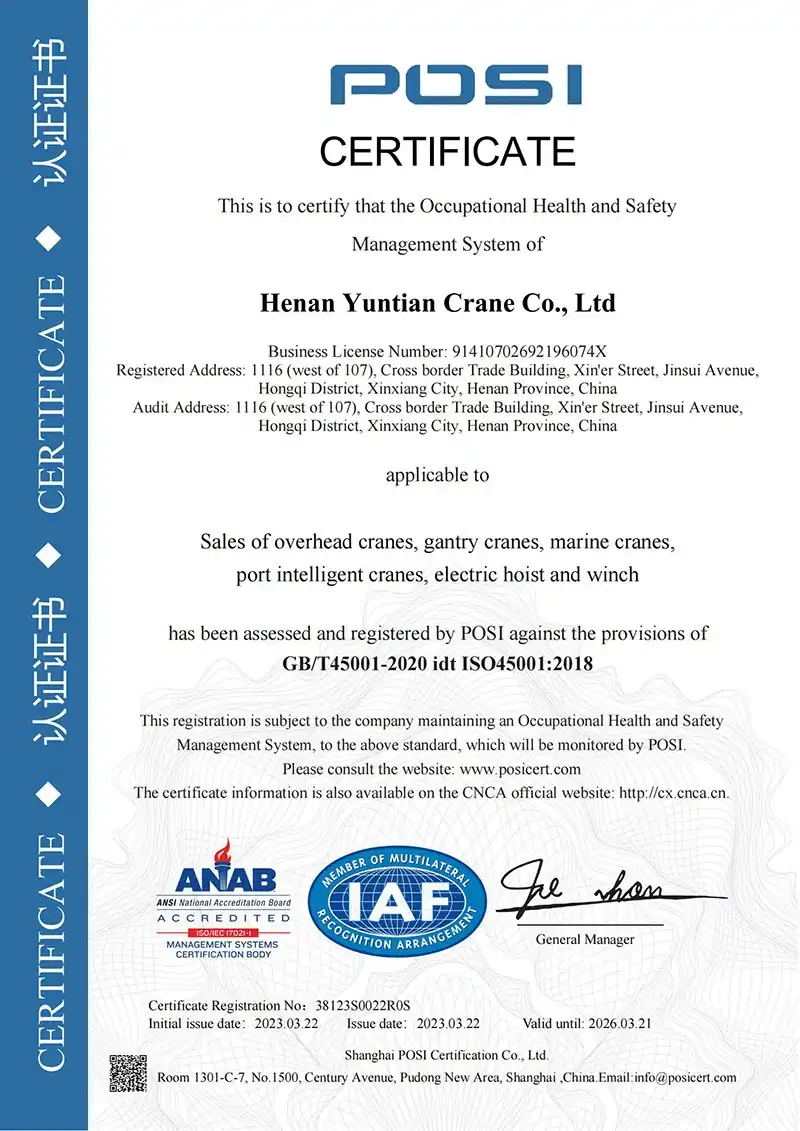





The Four-Link Portal Crane is a high-performance, mobile, full-revolving crane. It is designed for heavy-duty work in ports, dockyards, metallurgy, and construction. Its four-bar linkage mechanism offers great stability, accuracy, and efficiency in moving materials.
It meets GB, ISO, FEM, and JIS standards. It is built to be strong, safe, and perform well.
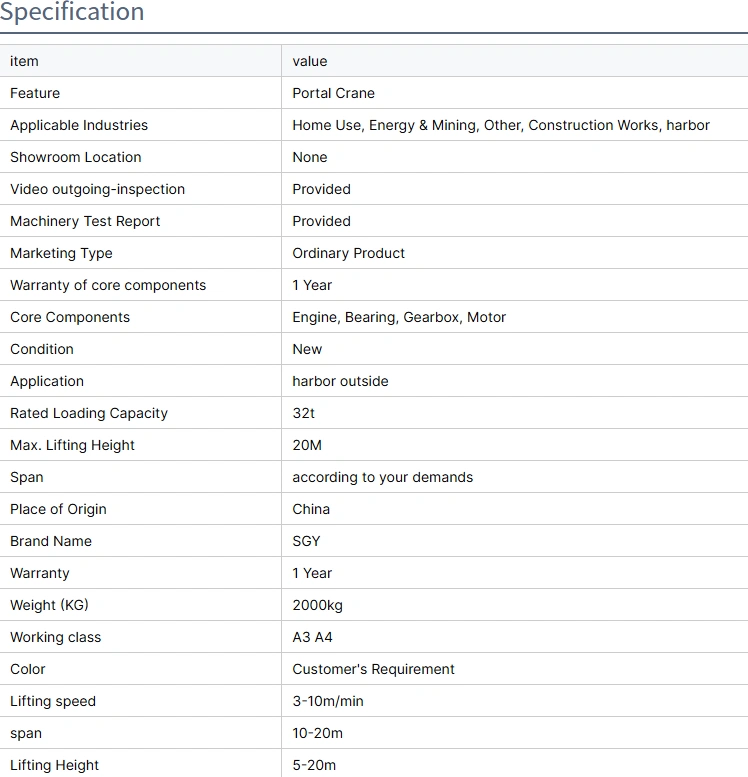
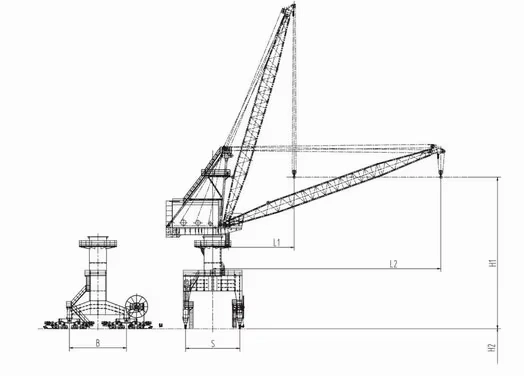
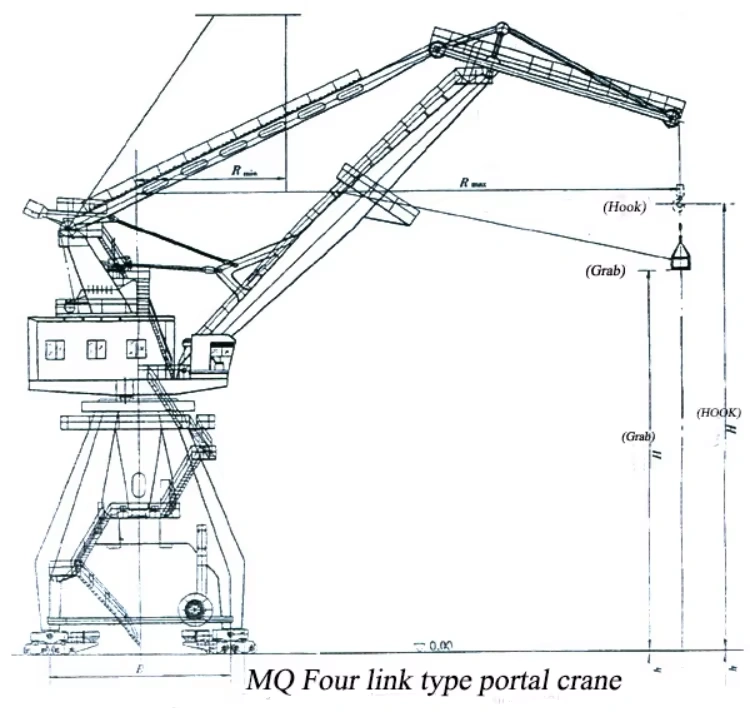
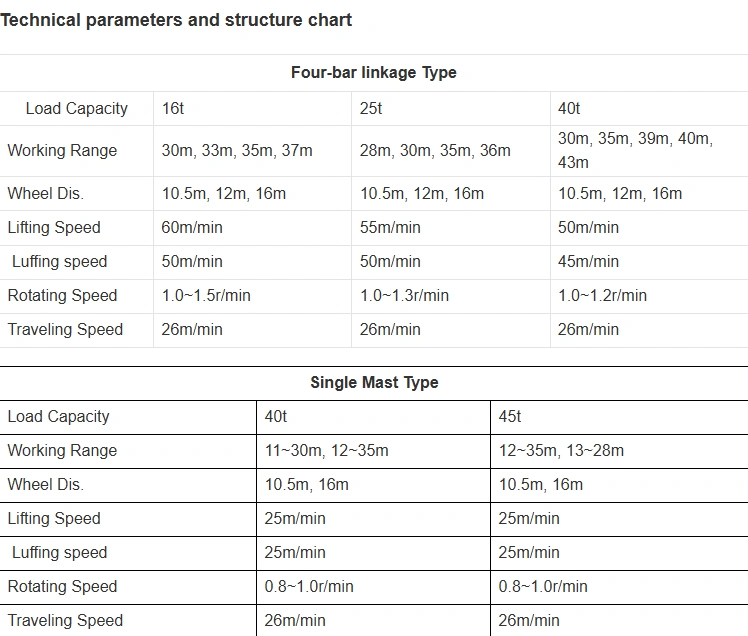
Key Advantages of Four-Link Portal Crane
-
Strong Structure
The four-link suspension keeps movement stable and reduces load sway.
The balanced jib and counterweight system improves lifting accuracy.
Two portal frame choices (cylinder or four outriggers) allow flexible use. -
Efficiency & Performance
Long boom reach – good for large ships and big work areas.
Smooth start and stop – reduces jerks for safer handling.
Low power use – saves energy and costs. -
Safety & Reliability
Meets GB6067-85 (safety) and GB3811-08 (design) standards.
Advanced braking and overload protection prevent accidents.
Stable travel system avoids derailment and allows smooth movement. -
Durability & Easy Maintenance
Made with high-strength steel (jib, A-frame, gantry) for long life.
Modular parts – easy to replace and repair.
Corrosion-resistant materials suit harsh environments like ports. -
Operator Comfort & Control
Large cabin with good view – less fatigue.
Low noise – better work environment.
Easy controls – improve handling precision.
Standards & Certifications
GB17495-1998 (Harbor portal crane specs)
GB6067-85 (Lifting safety)
GB3811-2008 (Crane design standards)
Also complies with ISO, FEM, JIS, DIN, IEC, AWS
This portal crane uses a four-link mechanism. During operation, the hoisting, luffing, and rotating mechanisms can work alone or together. All are controlled from the operator’s cabin.
The crane includes safety devices such as an overload limiter, aviation signal light, anemometer, power cable reel, anchor device, jacking points for maintenance, wind-proof tie-downs, and limit switches for all motions.
Power is supplied from a ground junction box. The supply is 10kV/50Hz. It goes through the junction box, the crane’s cable reel, medium-voltage switchgear, transformer, and central slip ring to reach the crane’s power system.
The crane works in three shifts, day and night. All motions are driven by AC variable frequency motors. It has a modern condition monitoring and control system. It works efficiently, has few failures, requires little maintenance, and has good service space. It is easy and comfortable to operate, following modern human-centered design.
The 40t—45m crane can use a hook or grab. It handles heavy items and bulk cargo. It is a multi-purpose portal crane made with advanced domestic technology. It has a rational structure, flexible and precise mechanisms, is safe and reliable, and is easy to maintain.
The crane performs hoisting, luffing, 360° rotation, and travels on rails. Hoisting, luffing, and rotation are working mechanisms; travel is non-working.
Main features:
2.1 The hoisting mechanism uses two double-drum units. The drums are made of welded steel. They can work together with a hook, or separately for grab opening/closing and lifting. The reducer and drum are designed to last as long as the hoisting mechanism.
2.2 The luffing mechanism uses rack and pinion drive. The rotation mechanism uses a double-row roller slewing bearing, a vertical planetary reducer, foot-controlled variable frequency brake, and a torque limiter.
2.3 The travel system has four bogies. Each is connected to the balance beam and portal frame with hinges for even force distribution. It uses triple-unit drives with electric wheel clamps for braking. Wind-resistant cables are attached outside the legs. Each leg has a hinge that can rotate 90° horizontally (locked with bolts during work). Jacking devices are placed at suitable points on each leg.
2.4 The 40t—45m four-link portal crane uses a rigid four-link balanced weight boom system. The column and slewing platform are welded box-girders. The upper part of the portal frame is a cylindrical structure. The top is welded to a thick rolled flange where it connects to the slewing bearing, reducing stress concentration. The slewing bearing is bolted to the platform and the flange on the cylinder using high-strength pre-tightened bolts. The lower part of the portal frame is a sealed box structure.
2.5 The electrical control uses a full PLC system with real-time monitoring. Hoisting, luffing, travel, and rotation all use variable frequency speed control.
2.6 The machinery house has lifting points for the heaviest single part. Ventilation is good. A modern leak-proof rope outlet is installed on the roof. The electrical room is separate from the machinery room. It has a suspended ceiling, PVC raised floor with insulated mat, and air conditioning (one 2-horsepower wall unit and one 3-horsepower cabinet unit).
The operator’s cabin has a control console and an adjustable aviation seat. It is also equipped with complete instruments, meters, communication devices, and clear sound and light alarms. Air conditioning (a 1.5-horsepower split unit) provides a comfortable environment. The floor uses PVC raised steel floor plates and insulated mat. Stairs and platforms are well-designed for easy access. Main stairs and platforms use hot-dip galvanized grating for good rigidity, slip resistance, and corrosion resistance.
The crane includes a moment limiter.
Environmental conditions:
Max temperature: 45°C
Min temperature: -10°C
Max wind speed during operation: 25m/s
Max wind speed when not working: 55m/s
Max humidity: 100%
Climate: marine, with salt spray and dust
Earthquake: intensity 7 (modified Mercalli scale)
Standards and rules:
The design, manufacture, installation, and testing of this crane follow the latest versions of the standards below.
Note: Where Chinese standards do not specify, international standards apply. Imported parts follow international standards; domestic parts follow Chinese standards.
Main technical parameters
Design conditions on site
Rail gauge: 10.5m
Rail type: QU100
Wheel pressure: ≤300KN
Power supply: AC 10KV ±10%, 50Hz ±1Hz (with cable allowing 200m travel each way)
Main technical parameters
Working radius: 12.5m~45m, rated load: 40t
Working radius: 12.5m~30m, rated load: 50t
Hoisting height: above rail: 22m (grab), 31m (hook); below rail: 17m
Slewing range: full circle
Travel distance: ±200 m
Hoisting speed: 40t: 55m/min; 50t: 30m/min
Average luffing speed: 45m/min
Slewing speed: 1.2/0.8 rpm
Travel speed: 26m/min
Gauge: 10.5m
Portal clearance height: ≥6m
Tail turning radius: ≤9m
Duty class
Use class: U8
Load state: Q4
Duty class: A8
Main configuration
Main structure: Four-link portal type (high stability + full-range rated capacity).
Grab system: Four-rope double-jaw grab (for material density 0.8–3.2t/m³; handles coal, ore, grain, etc.).
Smart control: Includes load limiter, moment limiter, and automatic handling programs.
Technical strengths
✅ High efficiency: Two-speed hoisting—steady with heavy loads, fast with light loads.
✅ Stable operation: Four-link structure keeps loads level during luffing (unlike single-jib cranes).
✅ Safety: Two-level protection (electrical + mechanical rail clamps), suitable for complex port conditions.
Key parameters (example)
| Item | Parameter |
|---|---|
| Rated load | 40t (grab/hook), 60t (hook) |
| Grab capacity | 25m³ (for high-density materials) |
| Working radius | 11m (min) ~ 37m (max) |
| Hoisting speed | 30m/min (60t), 50m/min (40t) |
| Portal clearance | ≥7m (for vehicles and equipment) |
Installation steps
Check foundation and track levelness and load capacity. Ensure travel mechanism is installed accurately.
Assemble slewing mechanism and boom system on site after transport. Carefully align the four-link synchronization.
Install four-rope drums for grab. Adjust rope ratio (5 parts for heavy load). Improve grab open/close response.
Test all motions without load—travel, slewing, luffing, hoisting. Check sensor sensitivity.
Perform load test (key step):
110% dynamic overload test: lift 82.5 tons to check structural strength.
Continuous operation test: 8 hours at full load. Monitor temperature, vibration, and system stability.
Applications
The Four-Link Portal Crane is used in many industries:
✅ Ports & Terminals – For containers, bulk cargo, and loading or unloading ships.
✅ Dockyards & Shipbuilding – Moves heavy machinery and materials.
✅ Metallurgy & Mining – Transports raw materials like steel, ore, and ingots.
✅ Construction & Infrastructure – Lifts beams and prefabricated structures.
✅ Logistics & Warehousing – Handles large-span gantry operations.
Why Choose the Four-Link Portal Crane?
✔ Better precision and stability – The four-link mechanism reduces load swing.
✔ Works with different attachments – Like hooks, grabs, container spreaders, and electromagnets.
✔ Saves energy and costs – Low power use cuts operational expenses.
✔ Meets global standards – Follows international safety and performance rules.
The four-link portal crane uses a combined boom system. This allows the load to move horizontally during luffing. It has little height change, smooth luffing, and low energy use. It can handle general cargo, bulk cargo, and containers. It is widely used, works efficiently, and operates steadily. The crane can rotate and cover a large work area. It meets handling needs for different cargo types.
This model looks modern, works safely, and has advanced performance. It is easy to maintain and built to last. It is widely used in major ports. It is ideal for multi-cargo terminals.
The four-link portal crane is a common type of slewing crane. It is used in ports for cargo handling, shipyards for building and installing ships, and large hydropower dam projects. The four-link boom is a key part of the crane. It transfers the load to the slewing platform. The boom design affects the crane’s weight, stability, and performance.
Many general terminals that handle both general and bulk cargo still use portal cranes. But when handling containers, these cranes often have problems. Simple spreaders are hard to position, operation is complex, and loads tilt and swing badly. This results in low efficiency. Terminals need a solution.
The dual four-link portal crane can use electric container spreaders. It solves key handling problems. For bulk handling, the crane can switch to a tipping or rotating spreader. This loads bulk material onto ships. The crane also has an automatic truck loading hopper. It unloads bulk into trucks. These systems work together for enclosed operation. This upgrades the standard dual four-link crane into a green, eco-friendly model.
It not handles containers steadily but also achieves zero dust and pollution in bulk handling. So the green dual four-link multi-purpose portal crane has great market potential.
Standard four-link cranes usually use a grab for bulk and a hook for general cargo or containers. When lifting containers, the wire rope is paid out from the drum. It passes through the sheaves on the head of the boom and connects to the hook. Different spreaders can be used under the hook. For example, a rotating hook with a container spreader below it can be used with four hoist ropes. In this system, the four ropes are arranged in a row. During slewing and luffing, the hook swing causes the container to tilt, shake, and hard to position. This reduces quality and efficiency. Also, handling bulk cargo creates dust, which does not meet green standards.
To solve these problems, the green dual four-link portal crane was developed. First, a small four-link mechanism was added to the main boom head. This makes the hoist ropes form a rectangle above the spreader. The ropes adjust automatically in both vertical and horizontal directions. This keeps the container stable and improves efficiency.
Second, a standard spreader only lifts and releases containers. But if replaced with a tipping or rotating spreader, the crane can load bulk onto ships.
Third, the crane has an automatic truck loading hopper. The crane moves the hopper along the rail using links. It recognizes trucks and loads them automatically. It records the loading data and sends it to the control room. The control room also monitors the site with cameras. In emergencies, it can stop operation remotely.
Dual Four-Link Structure
The dual four-link portal crane has a main four-link system and a small four-link system. The main system includes the main boom, large tie-rod, and boom tip. The small system has a front compensator, rear compensator, and sheaves. One end of the front compensator is attached to the boom tip. The other end connects to the rear compensator with sheaves. The rear compensator is attached to the main boom.
The hoist ropes from the drum pass over the sheaves on the boom tip. Some ropes go through the small four-link sheaves. The rest come directly from the boom tip. This makes the ropes form a trapezoid layout. If the spreader tends to tilt, the ropes on the opposite side pull tighter. This limits the tilt. Also, the front compensator keeps a fixed angle to the horizontal at all working radii. This keeps the sheaves in a steady position horizontally and vertically. So the spreader stays level.
Besides, if the hoist ropes bypass the small system and come only from the boom tip, the crane can use standard hooks or grabs like a regular portal crane. This makes it multi-functional.



